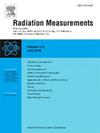基于深度学习方法和蒙特卡罗建模的定量α光谱同位素识别
IF 2.2
3区 物理与天体物理
Q2 NUCLEAR SCIENCE & TECHNOLOGY
引用次数: 0
摘要
对样品中的放射性同位素进行定量鉴定是环境辐射污染监测的重要内容。基于能谱的核素识别是环境辐射测量中最常用的方法,已被广泛用于伽马射线发射同位素的测量。本文提出了一套基于深度学习方法的定量α光谱分析和α同位素鉴定的完整流程,并证明了在深度学习模型开发中使用蒙特卡罗模拟的有效性和可行性。基于Python的Keras框架开发并实现了具有6个隐藏层(约70万个可训练参数)的深度学习模型。本文提出的深度学习模型没有使用复杂的光谱特征提取算法,而是直接使用光谱数据作为输入,可以输出每个核素的权重向量,其元素-having -的含义是每个核素的百分比含量。为了训练所提出的模型,需要大量的训练光谱,并且不可能通过测量来准备所有需要的数据。在这项研究中,蒙特卡罗模拟作为一种替代方法,通过混合单个核素的基本光谱来产生大质量的α光谱。在市售堪培拉α计的基础上,通过Geant4模拟生成了一组来自单个核素的α光谱。为了模拟光谱具有广泛的代表性,考虑了不同的测量条件,制备了500多个基本光谱,形成了一个数据库。从库中随机选取基本谱,用随机权值求和,生成数百万个训练谱。利用生成的400万个光谱对模型进行训练,并通过基于生成的光谱库中的光谱、Geant4模拟混合核素的光谱和实际混合α源的测量3种光谱对模型进行测试。将模型预测鉴定的百分比含量与原始权重值进行比较,验证了光谱中核素的定性和定量鉴定。模拟光谱鉴定核素百分比含量的绝对误差小于1%,实际测量光谱鉴定核素百分比含量的绝对误差小于2%。通过增加库中核素的数量、模拟中测量条件的范围和模型训练中生成的训练光谱数据集,可以进一步提高精度。结果表明,深度学习模式可以识别复杂α光谱中包含的核素,并能较好地确定核素的含量。该方法在定量光谱α同位素鉴定中具有很大的应用潜力。本文章由计算机程序翻译,如有差异,请以英文原文为准。
Quantitative alpha spectra isotope identification based on deep learning method and Monte Carlo modeling
It is essential to identify radioactive isotopes contained in samples quantitively for environment radiation contamination monitoring. Energy-spectra-based nuclide identification is the most commonly used method in environmental radiation measurement and has been widely used for gamma ray emitting isotopes. In this work, a complete procedure of quantitative alpha spectra analysis and alpha isotope identification based on deep learning method was proposed and it was proved effective and feasible to use Monte Carlo simulation in deep learning model development. Deep learning model with 6 hidden layers (about 0.7million trainable parameters) was developed and implemented based on Keras framework in Python. Instead of complicated spectrum feature extraction algorithm, proposed deep learning model used spectrum data as input directly and could output a weight vector of nuclides with elements - -having - meaning of the percentage content of every nuclide. To train the proposed model, huge number of training spectra were needed and it was not possible to prepare all needed data by measurement. In this study, Monte Carlo simulation was used as an alternative method to produce massive alpha spectra by mixing basic spectrumof single nuclide. Based on the setups of commercially available Canberra alpha meter, a set of alpha spectra from single nuclide were generated by Geant4 simulation. To broad representativeness of simulated spectra, different measuring conditions were taken into consideration and more than 500 basic spectra were prepared to form a data library. Randomly choosing basic spectra from the library were summed with random-weight to generate millions of training spectra. The proposed model was trained using 4 million generated spectra - and tested by 3 kinds of spectra, namely spectra from generation-based spectra library, Geant4 simulation of mixed nuclides and measurements of actual mixed alpha source. The identified percentage contents by model prediction were compared with the original weight values to validate qualitative and quantitative identification of nuclides contained in spectra. Absolute errors of identified nuclide percentage contents were less than 1% for simulated spectra and less than 2% for acutal measured spectra. The accuracy could be improved further by increasing the number of nuclides contained in library, the range of measuring conditions in simulation and the data set of generated training spectra used in model training. Results indicated that deep learning mode could identify the nuclide contained in complicated alpha spectra and determine the content of nuclide with good accuracy. The method proposed in this study has great potential in quantitative spectral alpha isotope identification.
求助全文
通过发布文献求助,成功后即可免费获取论文全文。
去求助
来源期刊

Radiation Measurements
工程技术-核科学技术
CiteScore
4.10
自引率
20.00%
发文量
116
审稿时长
48 days
期刊介绍:
The journal seeks to publish papers that present advances in the following areas: spontaneous and stimulated luminescence (including scintillating materials, thermoluminescence, and optically stimulated luminescence); electron spin resonance of natural and synthetic materials; the physics, design and performance of radiation measurements (including computational modelling such as electronic transport simulations); the novel basic aspects of radiation measurement in medical physics. Studies of energy-transfer phenomena, track physics and microdosimetry are also of interest to the journal.
Applications relevant to the journal, particularly where they present novel detection techniques, novel analytical approaches or novel materials, include: personal dosimetry (including dosimetric quantities, active/electronic and passive monitoring techniques for photon, neutron and charged-particle exposures); environmental dosimetry (including methodological advances and predictive models related to radon, but generally excluding local survey results of radon where the main aim is to establish the radiation risk to populations); cosmic and high-energy radiation measurements (including dosimetry, space radiation effects, and single event upsets); dosimetry-based archaeological and Quaternary dating; dosimetry-based approaches to thermochronometry; accident and retrospective dosimetry (including activation detectors), and dosimetry and measurements related to medical applications.
 求助内容:
求助内容: 应助结果提醒方式:
应助结果提醒方式:


